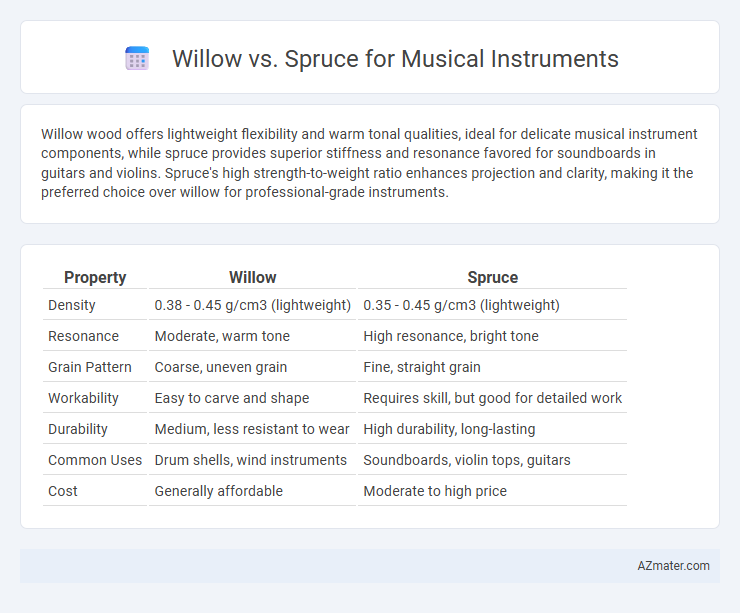Willow wood offers lightweight flexibility and warm tonal qualities, ideal for delicate musical instrument components, while spruce provides superior stiffness and resonance favored for soundboards in guitars and violins. Spruce's high strength-to-weight ratio enhances projection and clarity, making it the preferred choice over willow for professional-grade instruments.
Table of Comparison
| Property | Willow | Spruce |
|---|---|---|
| Density | 0.38 - 0.45 g/cm3 (lightweight) | 0.35 - 0.45 g/cm3 (lightweight) |
| Resonance | Moderate, warm tone | High resonance, bright tone |
| Grain Pattern | Coarse, uneven grain | Fine, straight grain |
| Workability | Easy to carve and shape | Requires skill, but good for detailed work |
| Durability | Medium, less resistant to wear | High durability, long-lasting |
| Common Uses | Drum shells, wind instruments | Soundboards, violin tops, guitars |
| Cost | Generally affordable | Moderate to high price |
Introduction to Willow and Spruce in Musical Instrument Making
Willow and spruce are notable tonewoods in musical instrument making, each offering distinct acoustic properties. Spruce, prized for its lightweight strength and resonant qualities, is commonly used in soundboards for guitars, violins, and pianos due to its ability to enhance projection and clarity. Willow, less traditionally used but valued for its softer grain and warm tonal character, finds application in certain percussion instruments and specialized string instruments where a mellower sound is desired.
Physical Properties of Willow vs. Spruce
Willow wood, characterized by its lightweight and moderate density, offers a softer texture and lower stiffness compared to spruce, making it less resonant but providing unique tonal warmth in musical instruments. Spruce is renowned for its high strength-to-weight ratio, exceptional stiffness, and fine grain structure, which contribute to its superior resonance, bright tonal clarity, and dynamic responsiveness, making it the preferred choice for soundboards in acoustic guitars, violins, and pianos. The physical properties of both woods influence sound projection and durability, with spruce delivering more sustain and projection while willow contributes to a mellower, softer sound profile.
Tonal Qualities: Willow Compared to Spruce
Willow offers a softer, warmer tone with a rich midrange, making it ideal for instruments requiring a mellow sound profile, while spruce provides a bright, clear, and resonant tone favored for its dynamic range and projection. The open grain structure of willow enhances its resonance but limits its sustain compared to the tight grain of spruce, which contributes to longer sustain and pronounced articulation. Musicians seeking warmth and a vintage vibe often prefer willow, whereas spruce remains the standard for classical and acoustic instruments due to its superior tonal clarity and responsiveness.
Workability and Carving Differences
Willow wood offers superior workability and carving ease due to its softer grain, making it ideal for intricate musical instrument details. Spruce, while harder and less forgiving to carve, provides exceptional strength and resonance, favored for soundboards in instruments like violins and guitars. The choice between willow and spruce balances detailed craftsmanship with acoustic performance demands.
Durability and Longevity in Instruments
Spruce is renowned for its exceptional durability and longevity in musical instruments, often used for soundboards due to its stiffness-to-weight ratio, which ensures sustained tonal clarity over time. Willow, though less common, offers moderate durability but lacks the structural integrity of spruce, making it less ideal for long-lasting instrument construction. Instruments crafted from spruce maintain their acoustic properties and resist wear better, making them the preferred choice for professional-grade and enduring musical craftsmanship.
Common Instrument Applications: Willow vs. Spruce
Spruce is the preferred wood for acoustic guitar tops and violin soundboards due to its superior stiffness-to-weight ratio, which produces bright, resonant tones essential for stringed instruments. Willow, while less common, is occasionally used in drum shells and certain woodwinds for its softer, more flexible properties that contribute to warm, mellow sound qualities. The ideal choice depends on the desired tonal characteristics, with spruce favored for clarity and projection, and willow valued for its damping effects and warm resonance.
Cost and Availability of Willow and Spruce
Spruce is widely available and generally more affordable due to its common use in musical instrument manufacturing, particularly for soundboards in guitars and violins. Willow, however, is less commonly used and tends to be more expensive and harder to source, as it is not a traditional choice for instrument making. The cost difference often makes spruce the preferred option for both beginners and professionals seeking value without compromising tonal quality.
Sustainability and Environmental Impact
Willow wood offers high sustainability due to its fast growth rate and renewable harvesting practices, making it an eco-friendly choice for musical instruments. Spruce, while prized for its resonant tonal qualities, often faces environmental concerns related to slow growth and overharvesting in old-growth forests. Choosing willow aligns with efforts to reduce deforestation and promote sustainable forestry, minimizing the carbon footprint associated with instrument production.
Real-World Examples and Luthier Preferences
Willow wood, prized for its lightweight and resonant qualities, is occasionally used in violin soundboards for its warm tonal properties, though spruce remains the dominant choice due to its superior stiffness-to-weight ratio and clarity. Luthiers such as Jean-Baptiste Vuillaume and contemporary makers favor Sitka spruce for guitars and violins because it offers consistent resonance and projection essential for professional performance. Real-world examples include Martin guitars utilizing Adirondack spruce for its dynamic range, whereas willow's application remains niche, often reserved for experimental or folk instruments aiming for softer, mellower sounds.
Choosing the Right Wood: Willow or Spruce?
Spruce is the preferred wood for musical instruments due to its exceptional strength-to-weight ratio, offering bright, clear tones and excellent resonance, making it ideal for soundboards in guitars and violins. Willow, while less common, provides a unique tonal warmth and softer sound but lacks the stiffness and durability required for most stringed instrument tops. Choosing between willow and spruce depends on desired tonal qualities, with spruce favored for projection and clarity and willow suited for niche acoustic textures.

Infographic: Willow vs Spruce for Musical Instrument
 azmater.com
azmater.com